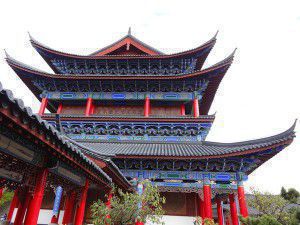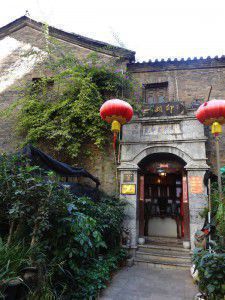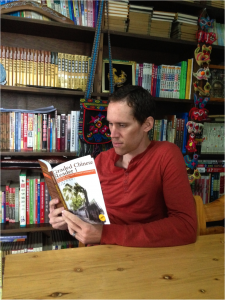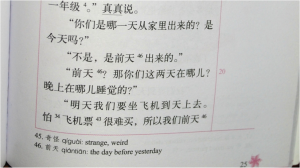How well do you know Chinese New Year?
Happy Chinese New Year! Here’s hoping the Year of the Goat (or possibly Sheep) is a good one.
See how much you know about this important Chinese holiday with our quiz. How many did you get right?
10 reasons to visit… China
China is an amazing country, one that should be on every traveler’s must visit list. Few countries possess the wide variety of experiences you will find in the Middle Kingdom. While you are in this amazing country, be sure to visit the province of Yunnan, one of the lesser known, but most beautiful destinations within China. Here are ten terrific reasons why you should visit China, by Anna Smith, who studies Chinese in China at Keats School.
1. Breath-taking landscapes
As one of the largest countries in the world, China boasts incredibly diverse landscapes. Virtually whatever scenery you find most beautiful, you will find it in China. From the Northwest deserts to the Southeast seacoast, high mountain ranges to fertile plains, the frozen beauty of Harbin to the lush warm tropics of Xishuangbanna, China has it all. Hangzhou is famous for its stunning West Lake views. Suzhou has beautiful garden views and winding rivers with traditional architecture. And Hainan is the tropical paradise of the Orient; known as the ‘Eastern Hawaii’; it is China’s own paradise island.
2. Wonderful people
As the most populous nation in the world, China has plenty of people to meet. Chinese people generally love Westerners, so most are quite friendly. Everywhere we go, people want to stop and chat and take pictures with us. You can meet some amazing people and hear many intriguing life stories in the Middle Kingdom.
3. Awesome language
To a native English speaker, Mandarin can seem intimidating because it is so different to European languages. But this uniqueness makes it all the more beautiful and amazing to experience. Chinese characters are stunningly beautiful. Listening to tonal Mandarin can be like experiencing a new kind of music for the first time. If you already playing with the thought of challenging yourself, then you should definitely check out these reasons to study Chinese at Keats School.
4. Incredible food
While known for its tea and rice, there is much more to Chinese cuisine than is commonly known by most Westerners. And this cuisine varies greatly by region. In the north, noodles are the most common meal staple, but in the south, almost everything is served over rice. Different regions, like Sichuan and Hunnan, are known for their unique spicy food, while coastal regions boast a variety of seafood. Some of the most fun and interesting foods to try are street foods, such as roasted sweet potatoes and Chinese barbecue, shao kao.
5. Rich history
Few places have such a vast and rich history as the Middle Kingdom. The Great Wall of China and the Terracotta Warriors are some of the most well known ancient tourist attractions. The Forbidden City and Temple of Heaven in Beijing are also must-see attractions to learn about Chinese history and culture.

Royal Palace, Lijiang. Ancient traditional buildings can still be easily seen in many cities in China.
6. Modern development
At the same time, China boasts some of the largest cities in the world and is becoming more modern everywhere you look. Nowhere else have I ever seen so many high rises or amazing skylines as in China. Shanghai epitomises modern day China, with the famous modern riverfront skyline known as the Bund, large European style buildings, and its particularly distinctive Pearl of the Orient tower.
7. Amazing markets and exciting products
True, China makes a wide variety of products that are exported all over the world, but they have many unique products as well. Fine silks, exquisite China tea sets, elaborately carved jade, and expensive aged tea are some of the most sought after high-priced commodities. But Chinese Calligraphy, bamboo baskets, traditional Chinese knots, and other handcrafted items are distinctly beautiful as well. Provinces in the southwest of China have a wide variety of unique items hand crafted by the many minorities within its borders.
8. Fascinating diversity
One of the most amazing things about China is the variety of experience that can be enjoyed in one place. Old and new, sweet and spicy, rough and smooth, all combine into a rich cultural tapestry. Because of its ethnic and topographical diversity, Yunnan holds incredible diversity in one province.
9. Mind-blowing memories
Because there are so many unique and diverse things to experience, a trip to China is sure to create some incredible memories. These experiences will travel with you for the rest of your life. My family and I have experienced so many wonderful memories. Especially exciting to my young boys are eating jiaozi and watching fireworks during Spring Festival. Our experiences shape who we are as people. One of the best reasons to visit any new place is to literally expand your horizons, as it can change your thoughts and life. China’s incredible variety allows you to enjoy a multitude of new experiences and will forever change you.
10. Charming calligraphy
The ancient art of Chinese calligraphy cannot be fully appreciated without visiting China and seeing masters create their works of art in person. Even in the smallest shop, a true master can create amazing works of art. Words become art to be enjoyed be all, even if you don’t understand the meaning. But there are many places where you can learn famous Chinese sayings and begin to learn Chinese calligraphy for yourself, which deepens your admiration for its beauty even more. Being able to write in Chinese is a very valuable skill, but often feels impossible to learn. Once you understand the fundamentals, you will see that this is indeed something that you can learn.
Anna Smith
You can’t beat visiting China for learning the language – but before you go, remember to learn a few basic words with uTalk to get you started.
A language learning love story
Why learn a language this new year? Well, for one thing, you never know where it might take you.
Meet Ed. He thought he was just going out for a meal with friends. Little did he know what was about to happen…
And if Ed and Mei Li have inspired you to learn a new language, why wait? Download uTalk or visit our website now!
Why learn Chinese Chengyu?
Today’s guest post is by Joe Paterson, a student at Keats School in China. Joe explains Chinese chengyu, which are absolutely fascinating and a perfect example of why we love languages so much – they’re all so unique and interesting. Do any Chinese speakers have more examples – or does the language you’re learning have an equivalent?
 Each language has its own idiomatic richness. English is full of proverbs, sayings and odd phrases like ‘Bob’s yer uncle’. Chinese is no exception. When you learn Chinese in China, you will definitely come across all kinds of interesting and creative ways of saying and expressing things. 土包子 (tubaozi/earth steamed-bun) means a country bumpkin or someone with backward or poor taste, and to wear 绿帽子 (lv maozi/ green cap) means to be cuckolded. But perhaps the most uniquely Chinese idioms are 成语 (chengyu).
Each language has its own idiomatic richness. English is full of proverbs, sayings and odd phrases like ‘Bob’s yer uncle’. Chinese is no exception. When you learn Chinese in China, you will definitely come across all kinds of interesting and creative ways of saying and expressing things. 土包子 (tubaozi/earth steamed-bun) means a country bumpkin or someone with backward or poor taste, and to wear 绿帽子 (lv maozi/ green cap) means to be cuckolded. But perhaps the most uniquely Chinese idioms are 成语 (chengyu).
Chengyu are four character phrases that can be thrown into daily conversation but will throw up a wealth of meaning and significance to the interlocutor. Some of these phrases seem quite bizarre without a context, but many have a background story which explains the meaning and also conjures up images that reinforce the word’s meaning.
The first chengyu we will look at is 东施效颦 (Dongshixiaopin/ Dong Shi effect frown). The literal translation is altogether puzzling but a native speaker would instantly know the meaning to be to imitate someone but have the opposite to the desired effect. It is only when we know the background story to the saying that we can fully comprehend it. The story goes that there was a beautiful girl named Xi Shi in the ancient Yue state who was admired by everyone in the village. However Dong Shi, another girl, was ugly and could never command attention. One day when Xi Shi fell ill she walked out of the door holding her hand to her breast, her face contorted in pain. All the villagers were concerned at her trouble and pain. Seeing this, Dong Shi attempted to imitate her mannerism. But when the villagers saw such a grotesque sight they were repulsed and ran away.
Nowadays people might use 东施效颦 to describe someone blindly imitating a pop star’s outfit, only to be ridiculed themselves for looking stupid. Or, someone plagiarising another’s business idea only to find themselves go bankrupt.
The second chengyu is 刻舟求剑 (ke zhou qiu jian/mark boat search sword) which means to pursue a goal despite changing circumstances that should be considered, or, in short, being stubborn in a foolish pursuit.
The phrase comes from a story where a man drops his beloved sword into a river. He marks the side of the boat to show where the sword fell in. Once at the shore he dives back in to find the sword but to no avail. Of course between marking the boat and getting to the shore the boat has moved downstream. An example of when his phrase could be used might be if someone insists in investing in a certain product even if research shows that the product might not sell.
Other phrases are not strictly chengyu but are made up in the same structure and used in daily speech, even though most people may not know the exact origin of the term.
乱七八糟 (luan qi ba zao/confusion seven eight pickle) is a word used to describe anything messy and unorganised, from a bedroom to the way in which someone does something. The phrase actually originates from a late Qing dynasty novel by Zeng Pu, in which he describes the way craftsmen used to keep their workshops in a 乱七八糟 state.
Many common chengyu may not have such an interesting background but serve to colour the language with images that are created by the visual characters themselves or their meaning. 自讨苦吃 (zi tao ku chi/ self ask for bitter eat) provides an image for the idea to ‘ask for trouble’ and 利欲熏心 (li yu xunxin/ profit desire smoke heart) would be the equivalent of the English phrase ‘blinded by greed’, but creates an interesting image of the desire for profit creating a vapour masking the heart.
The ability to use chengyu well is very much admired in China and so it is well worth trying to improve one’s own use and trying to learn more. After a while some chengyu become so natural to explain a certain scenario or situation that sometimes they even surpass one’s own mother tongue equivalent word or phrase. Taking a Chinese language course from a professional language school could help to establish one’s linguistic and cultural foundation to be able to understand and use chengyus in a versatile way.
Joe Paterson (Keats School)










